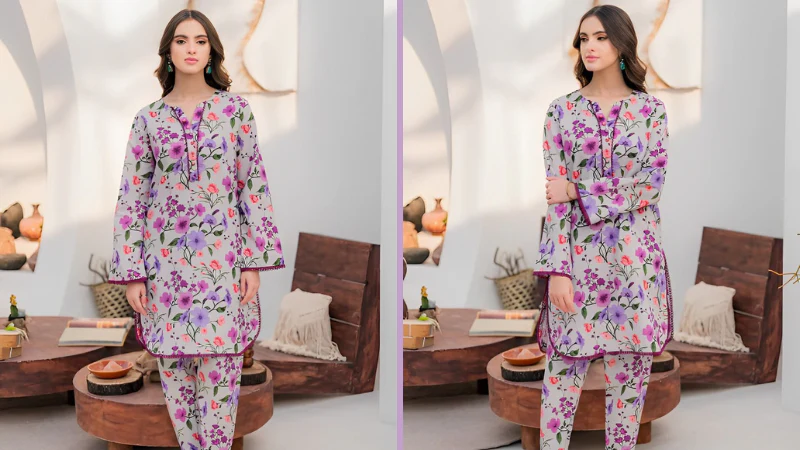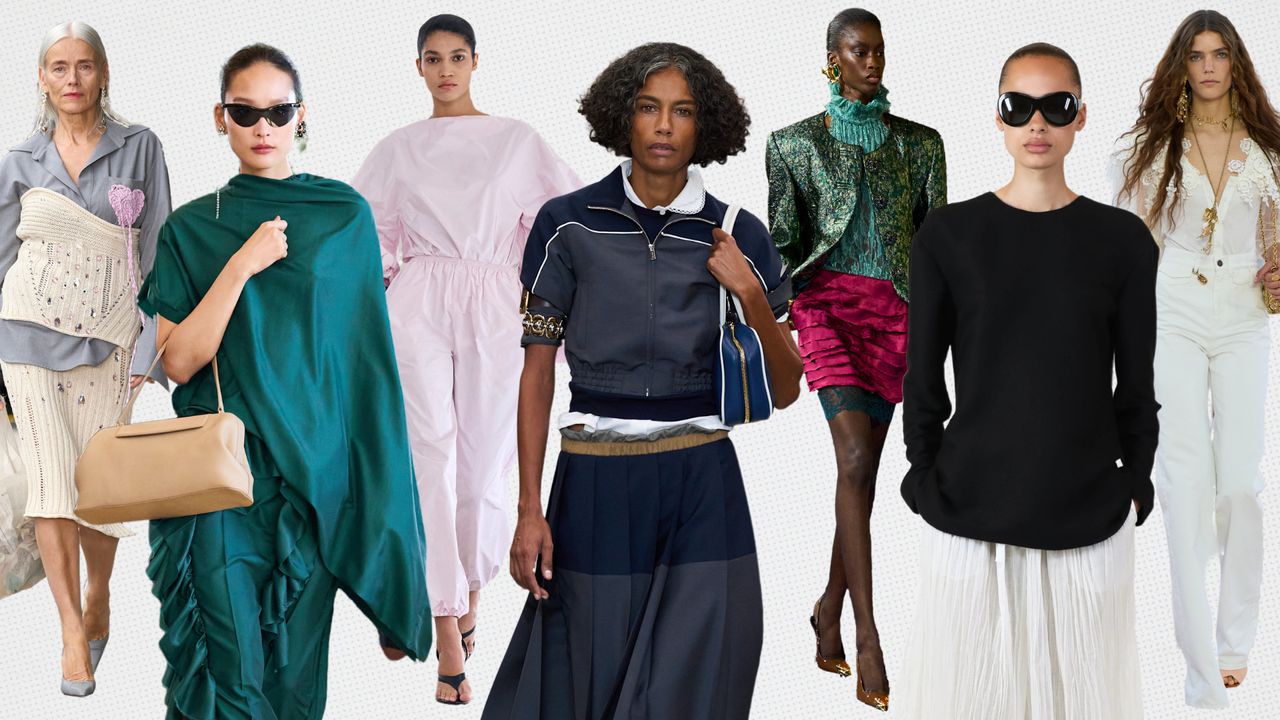FASHION
Pakistani Eid Dress Designs 2024: Style Inspiration for Your Celebration

Eid is a time to come together, celebrate, and embody the beauty of faith, tradition, and fashion. Each year, Eid traditions merge with contemporary trends, creating unique styles that reflect culture and individuality. The upcoming Eid season in 2024 promises stunning trends in Pakistani Eid dress designs for women, focusing on adorable baby girl outfits that perfectly blend tradition and modernity.
Whether you’re looking for a glamorous outfit for yourself or seeking a cute Eid dress for your little one, these designs are sure to inspire your wardrobe choices.
What’s Trending in Pakistani Eid Dress Designs 2024
Each Eid, fashion houses and local designers introduce vibrant, intricate designs that highlight the art and craftsmanship of Pakistani culture. Here’s what to expect in the latest trends for women and baby girls in 2024.
1. Traditional Elegance Meets Contemporary Cuts
Pakistani Eid dresses this year are seamlessly blending tradition with modern aesthetics. From flowing anghrakhas with asymmetrical cuts to lehenga cholis adorned with intricate zari and go to work, these designs remain rooted in heritage while catering to contemporary preferences.
For adults, you’ll see a rise in structured silhouettes like peplum tops paired with gharara pants or high-slit frocks with cigarette trousers. These designs give women the chance to add a sophisticated edge to their overall attire without compromising cultural values.
Fabric Choices
Expect to see luxurious fabrics like raw silk, chiffon, net, and organza, styled with delicate embellishments. These materials not only exude elegance but are also lightweight and perfect for lengthy Eid gatherings.
2. Vibrant Colors and Subtle Pastels
When it comes to Eid attire, colors play a huge role in setting the celebratory tone. For 2024, bold hues like emerald green, royal blue, deep maroon, and mustard yellow remain festival favorites. These rich colors, combined with metallic accents like gold or silver embroidery, create a striking ensemble perfect for Eid festivities.
Simultaneously, subtle pastels like blush pink, mint green, peach, and ivory are trending for those who want understated elegance. These tones are perfect for day-time festivities or minimalistic celebrants who prefer lighter shades.
3. Intricate Handwork and Artisanal Detailing
The intricate detailing on Pakistani Eid dresses truly sets them apart. Expect to see heavily embellished ensembles featuring zardozi, mirror work, patti, and sequins. Many designers incorporate hand embroidery that reflects time-honored techniques passed down through generations.
Creative blends of modern art-like motifs with traditional floral patterns will also dominate the design space, making every piece uniquely breathtaking.
Baby Girl Eid Dress Designs 2024
Eid is a joyous and magical time for kids—and what better way to capture the spirit of celebration than by dressing your little one in the cutest festive outfits? Baby girl Eid dresses for 2024 will charm you with their blend of cuteness, comfort, and style.
1. Anarkali-Inspired Frocks
Anarkali frocks for toddlers and baby girls remain popular favorites. These frocks often come with cascading layers of fabric, giving them the perfect spin for twirls! They’re usually paired with churidar leggings in vibrant colors or complementary pastels.
Look for embellished yokes, tiny sequins, and floral embroidery to add a festive appeal. Soft cotton inner linings ensure the dress is gentle on your baby’s skin, keeping her comfortable throughout the celebrations.
2. Peplum Tops and Skirts
Peplum tops paired with flowy skirts are trending in both adult and children’s fashion for Eid. For baby girls, the peplums feature bright hues with lighter embroidery or beadwork, paired with sparkling skirts that add a touch of glamor.
Opt for airy, lightweight fabrics like net or organza, ensuring your little one can move about freely. Add comfortable ballet flats or mini khussas to complete the adorable look.
3. Classic Shalwar Kameez for Kids
Traditional shalwar kameez tailored for baby girls is a timeless Eid favorite. Designed with breathable materials such as lawn or cotton, these come with fun embellishments like tiny lace trims, pom-poms, and pearls for a festive vibe.
Pair these with matching bangles and a light dupatta to keep her Eid-ready from head to toe.
4. Gharara and Sharara Sets
Tiny ghararas and shararas are perfect for baby girls who are ready to take part in all the dances and fun. Crafted from silk or organza, these sets often come adorned with dainty borders or gota detailing.
To enhance the outfit, complete the look with accessories like floral hairbands, dupattas, or cute jhumkas for kids.
Tips for Choosing the Perfect Eid Outfit
Selecting the right Eid dress for yourself or your little one involves more than just keeping up with trends. Here are some practical tips to ensure your choice is as functional as it is fashionable.
For Women
- Consider the venue and timings of your Eid festivities. Opt for lighter fabrics for daytime events and more embellished pieces for nighttime gatherings.
- Choose accessories that aren’t overwhelming. Statement earrings or a delicate clutch can enhance your look.
- Prioritize comfort, as celebrations often last for hours. Ensure your outfit allows easy movement.
For Baby Girls
- Comfort is key—choose soft, breathable fabrics that won’t irritate your little one’s delicate skin.
- Ensure fittings aren’t too tight, giving her space to play and move freely.
- Add small, safe accessories like bows or bangles—keep them lightweight and child-friendly.
Celebrate in Style
Eid is more than just a celebration—it’s an opportunity to express yourself through the rich heritage and evolving styles of Pakistani fashion. Whether you’re drawn to elaborate detailing, vivid hues, or minimal pastels, the 2024 Eid dress designs offer something for every taste.
Planning for your little one? Baby girl Eid outfits are cuter than ever this year, providing a picture-perfect look for those cherished family moments.
No matter your choice, remember that above all, Eid attire is about expressing joy and celebrating togetherness. This year’s vibrant trends will certainly make your celebration even more memorable.
Stay fashionable and festive this Eid!
FASHION
Softlips® Lip Balm: Why It’s Your Perfect Everyday Essential

Chapped lips are never a good look—or feel. But with so many lip balms on the market, how do you choose the one that truly works for you? Enter Softlips® Lip Balm, an all-time fan-favorite that keeps your lips looking and feeling amazing. Whether you’re braving winter’s harsh winds or soaking up the summer sun, Softlips is the go-to solution to keep your lips hydrated, smooth, and irresistibly kissable.
This blog will uncover the unique features of Softlips® Lip Balm:, explore why it stands out from competitors, and show you how it fits seamlessly into any daily routine. By the end, you’ll know exactly why this little tube deserves a permanent spot in your bag.
The Secret That Makes Softlips® Stand Out
Lip balms might all look alike, but Softlips® Lip Balm: packs a unique punch. What sets it apart from the rest? It’s all in the details:
1. Ultra-Hydrating Formula
The key to Softlips’ magic lies in its moisture-locking formula. Infused with ingredients like shea butter, antioxidant vitamin E, and sunflower seed oil, this balm ensures your lips stay supple and soft all day long. Unlike other products that leave a waxy residue, Softlips glides on effortlessly, delivering instant and lightweight hydration.
2. Broad Sun Protection (SPF 20)
Lips can be just as vulnerable to the sun as your skin, which is why Softlips includes SPF 20 in its formula. This built-in sunscreen offers critical protection against harmful UV rays, shielding your lips from potential dryness, cracking, and premature aging.
3. A Flawless Finish – Not Sticky or Heavy
Nobody enjoys the feeling of greasy lips. Softlips® Lip Balm:’ non-greasy texture sets it apart by creating a barely-there feel. It also leaves a subtle shine, making your lips look naturally polished without the “too glossy” effect.
4. Compact and Stylish Design
Its sleek, tube-style design makes it ultra-portable, so you can slip it into your pocket or bag and take it anywhere. Plus, Softlips® Lip Balm:’ minimalist and stylish branding gives it a sophisticated edge over traditionally bulky balms.
5. A Flavor for Every Mood
When was the last time a lip balm was fun? Softlips® Lip Balm: comes in a delightful variety of flavors, such as Vanilla, Strawberry, and Mint, ensuring there’s an option for everyone. These flavors add a refreshing twist to your skincare routine, creating a sensory experience you’ll actually look forward to.
Why Lip Care Shouldn’t Be Overlooked
Your lips deserve more love than they’re probably getting—and not just for cosmetic reasons. Did you know that lip skin is thinner and more sensitive than the rest of your body? This makes it prone to cracking, chapping, and sun damage, especially in harsh weather conditions.
By including lip care in your daily beauty routine, you ensure not only comfort but also long-term health. Softlips makes this easy with its multitasking benefits, combining hydration, sun protection, and added softness in one product.
How Softlips Fits Into Your Daily Routine
Whether you’re a minimalist or a skincare enthusiast, Softlips Lip Balm easily integrates into any lifestyle. Need some ideas? Here’s how you can use Softlips throughout your day:
Morning Prep
After brushing your teeth, swipe a layer of Softlips® Lip Balm across your lips to lock in morning moisture. It’ll prep your lips perfectly for lipstick or gloss.
Over-The-Day Touchups
Toss a tube in your purse or desk drawer for quick touch-ups throughout the day. Thanks to its small size and sleek design, it’s always ready when you need it.
Before Bed
Don’t forget lip care during your nighttime routine! Before heading to bed, apply a generous layer of Softlips to wake up with smooth, nourished lips.
Real Reviews, Real Results
Still wondering if Softlips is worth the hype? Don’t just take our word for it—here’s what loyal fans have to say:
- “Softlips is the only balm I’ll use. The lightweight feel is perfect, and it keeps my lips soft in even the worst winters!” – Emily R.
- “The SPF factor is a game-changer. I used to overlook how much the sun affects my lips, but now Softlips is my daily go-to.” – Mia T.
- “I love how it doesn’t feel sticky. Plus, the mint flavor? Absolute perfection!” – Jenna K.
Why Choose Softlips Over Other Brands?
Here’s how Softlips compares to common options in the market:
|
Feature |
Softlips® |
Other Balms |
|---|---|---|
|
Hydration |
Lightweight & lasting |
Can feel too greasy |
|
Additional Benefits |
SPF 20, flavors |
Usually just hydration |
|
Portability & Design |
Sleek, compact |
Often bulky & inconvenient |
|
Finish |
Soft, natural shine |
May leave a waxy residue |
From its multifunctional formula to its stylish packaging, Softlips stands head-and-shoulders above other brands. Whether you’re looking for a casual everyday balm or something to compliment your beauty routine, it delivers on all fronts.
Make Softlips® a Part of Your Life Today
If you’re ready to experience soft, hydrated lips that look as good as they feel, there’s no better time to shop Softlips. With its convenient design, effective formula, and SPF advantage, it’s more than just a lip balm—it’s a staple you’ll never leave home without.
Find your perfect flavor and see what makes Softlips a must-have for so many beauty enthusiasts. Shop Softlips today. Your lips deserve nothing less than the best!
FASHION
Fashion Snoops 101: Trend Forecasting & Consumer Insights

Fashion isn’t just about what’s in your closet—it’s a reflection of cultures, emotions, and the world at large. But how do brands predict what’s going to be the next “big thing”? That’s where Fashion Snoops comes in. Known as a global trend forecasting agency, this powerhouse helps brands understand where trends come from, how they evolve, and (most importantly) where they’re headed.
Whether you’re in fashion, beauty, interior design, or a niche consumer market, trend forecasting provides valuable insights that empower businesses to make smarter creative and marketing decisions. Keep reading to learn how Fashion Snoops helps businesses stay ahead of the curve with trend forecasting and consumer insights.
What Is Fashion Snoops?
Fashion Snoops is a trend forecasting and consulting agency that dives deep into the evolving intersection of culture, creativity, and commerce. More than just a crystal ball for style predictions, it’s a platform that combines data, industry research, and critical analysis to forecast emerging trends across industries.
Rather than focusing solely on fleeting fads, Fashion Snoops homes in on macro consumer behaviors and societal shifts. From there, it taps into key colors, materials, aesthetics, and themes that resonate on global and local levels.
What Sets Fashion Snoops Apart?
- Expert-backed Insights – Every forecast is grounded in thorough research conducted by seasoned analysts and trendspotters spread across the globe.
- Cultural Context – Instead of looking at trends in isolation, Fashion Snoops ties them to larger cultural movements or societal changes, offering context that makes trends feel more meaningful.
- Cross-industry Relevance – Their approach transcends fashion, bringing similar rigor to industries like beauty, interiors, food, and tech.
The Art of Trend Forecasting
Trend forecasting isn’t as simple as predicting what colors or shapes are popular next season. It involves an intersection of multiple disciplines, including cultural anthropology, data analytics, and creative intuition.
How Forecasting Works
- Investigating Cultural Shifts
Fashion Snoops looks at what’s happening in the world—politically, economically, and socially. For example, a rise in wellness culture has deeply influenced design choices in beauty, fitness, and even architecture.
- Analyzing Consumer Behavior
What are customers buying (or not buying)? This data allows brands to understand shifting priorities, whether that’s sustainability, personalization, or affordability.
- Spotting Emerging Visual Codes
Everything from street style to runway collections gets analyzed for emerging patterns. Think silhouettes, materials, and colors that convey particular moods or eras.
- Data-Driven Validation
Fashion Snoops doesn’t just guess at trends; they use data to validate their predictions. Tools like heatmaps and market analysis help confirm whether a forecast is worth following.
The Value of Trend Forecasting for Businesses
Why is everyone from indie designers to mega-brands subscribing to trend forecasting services like Fashion Snoops? Because not knowing—or misinterpreting—what consumers want could leave your brand irrelevant. Trend forecasting empowers brands to:
- Create products that align with upcoming desires.
- Build campaigns that resonate emotionally with customers.
- Stay innovative while maintaining relevance.
Consumer Insights: The Key to Understanding Your Audience
Keeping up with trends is one thing—but understanding the people who fuel those trends? That’s where consumer insights enter the equation. Fashion Snoops steers past blanket assumptions by identifying nuanced consumer segments and the values they prioritize.
Connecting with Micro-tribes
Today’s markets are fragmented into micro-tribes, such as “tech optimists” or “eco-conscious minimalists.” Each group has defined tastes and distinct decision-making processes.
For example, Gen Z consumers lean heavily into authenticity and sustainability. Meanwhile, millennials may focus on multi-functional products due to their busy lifestyles.
Personalization Through Data
Consumer insights provide brands with the details they need to create deeply personal experiences—think a catalog tailored to “classic neutrals” for one customer and “bold colors” for another.
Industry Applications of Fashion Snoops’ Tools
The versatility of Fashion Snoops extends across industries, making it indispensable beyond just fashion.
Fashion Snoops & Accessories
Brands can stay ahead of seasonality trends, whether it’s the rise of oversized blazers or the return of chunky jewelry.
Example Insight: Color forecasting predicts that earthy greens and muted purples will dominate Fall/Winter collections due to a broader cultural push toward reconnecting with nature.
Beauty & Wellness
From makeup formulas to packaging design, beauty brands rely on consumer insights to deliver what their audiences are craving.
Example Insight: Expect more unscented or hypoallergenic beauty products paired with minimalist bottles as part of the “clean, conscious beauty” movement.
Interiors & Lifestyle
Interior designers use trend insights to create spaces that align with seasonal aesthetics, like warm tones for fall or sleek metallic touches during winter.
Example Insight: Maximalist home décor, characterized by bold colors and eclectic patterns, is seeing a resurgence as consumers prioritize self-expression in their spaces.
Marketing Campaigns
Successful marketing is all about tapping into cultural touchpoints. Whether it’s through Instagram-worthy visuals or thoughtful sustainability messaging, these insights can supercharge campaigns.
Example Insight: Budgets are shifting toward TikTok-style, short-form content that feels authentic rather than overly polished.
The Future of Trend Forecasting
With technology evolving, the world of trend forecasting is poised to incorporate even more innovations. AI-based algorithms can now scan vast amounts of social media for emerging topics, making predictions faster and more accurate. Real-time consumer analytics? It’s already here, sharpening the predictive edge that tools like Fashion Snoops provide.
And as markets grow even more saturated, brands must continually ask themselves not only “What’s next?” but “What matters?”
Take Your Brand to the Next Level
Trend forecasting is no longer a luxury; it’s essential for businesses seeking to thrive in competitive markets. Fashion Snoops simplifies the process by equipping brands with actionable insights that spark creativity and boost sales.
If you’re ready to take the guesswork out of product launches and campaigns, now is the time to explore trend forecasting with Fashion Snoops. Make smarter, data-backed decisions to keep your business ahead of the curve.
FASHION
Fashion News and Trends Every Designer Should Know

The fashion industry is a constantly evolving canvas where innovation, creativity, and culture intersect. For designers, staying informed about changing trends, iconic models, and fresh style guides isn’t just beneficial—it’s essential for crafting collections that resonate.
This post dives into the latest fashion news and trends, spotlighting everything from emerging designers to the must-follow style movements for creating standout designs.
The Current Fashion Landscape
The global fashion industry is valued at nearly $2 trillion, making it one of the most influential creative industries. Designers are not only tasked with creating captivating garments but also with responding to societal shifts, sustainability demands, and advancements in technology. Here’s a glimpse into what’s shaping the industry today.
Sustainability Takes Center Stage
Sustainability in fashion is no longer a niche—it’s a requirement. Consumers demand transparency, and brands are stepping up. From Stella McCartney’s continued commitment to cruelty-free fashion to Gabriela Hearst using deadstock fabric for luxury designs, sustainability is influencing every aspect of the design process.
Key trends include:
- Upcycled Designs using waste materials like fabrics and plastic for new collections.
- Digital Fashion to reduce physical waste with virtual garments for avatars and digital showcases.
- Eco-Friendly Textiles, including organic cotton, recycled polyester, and biodegradable fabrics.
The Return of Maximalism
Maximalism is making a statement! Forget muted tones—vivid prints, bold colors, and exaggerated silhouettes are back on the runway. Designers like Balmain and Moschino lean into over-the-top aesthetics, incorporating striking details like gold embellishments and voluminous structures.
Why does this matter? Maximalism offers an unapologetic sense of individuality, which makes it appealing to clients who want their designs to reflect exuberance and self-expression.
Gender Neutrality and the Decline of Stereotypes
Fashion is seeing a remarkable shift toward gender-neutral clothing. Designers such as Palomo Spain and Telfar redefine inclusivity with pieces that challenge traditional silhouettes and gender norms. This trend allows designers to tap into broader and more diverse markets, fostering creativity without constraints.
Technology Alongside Tradition
Fashion tech continues to innovate—from AI-assisted design to fabrics engineered with nanotechnology for added function and durability. Leading brands like Gucci and Nike dip into NFTs (non-fungible tokens) and virtual experiential campaigns to bridge the physical and digital worlds.
Pro-Tip: Start exploring wearable tech collaborations. Hybridized garments like self-heating jackets or adaptable LED garments are likely to become mainstream.
Top Models Making Headlines
Models are more than just runway muses; they bring designs to life while driving trends forward. Meet the latest trailblazing icons shaping the fashion world.
- Adut Akech continues to rise as a leading face in global fashion campaigns, heralding diversity and originality.
- Alton Mason’s Androgyny breaks stereotypes on countless luxury runways.
- Paloma Elsesser’s Body Positivity Mission inspires discussions on inclusive size representation as she dominates editorials globally.
Working with models who embody authenticity and align with brand ethics further enhances storytelling opportunities within campaigns.
Style Guides to Influence Your Next Collection
1. The Color Palette Rules for 2024
Every successful collection begins with the perfect color palette. For 2024, expect:
- Digital Lavender—a soft, almost nostalgic pastel perfect for calming aesthetics.
- Cobalt Blue—an electrifying, versatile shade dominating streetwear.
- Rustic Earth Tones—ideal for bridging natural, sustainable stories.
Curate palettes inspired by pastels paired against statement colors.
-

 BUSINESS9 months ago
BUSINESS9 months agoQuest for Success with QuestHRSC
-

 BUSINESS12 months ago
BUSINESS12 months agoJack Vonarb Private Equity Revolutionizing the Industry
-

 TRADING12 months ago
TRADING12 months agoThe Ultimate Guide to Mastering grossoptions.com
-

 HEALTH5 months ago
HEALTH5 months agoThe Future of Payments in the Medical Industry: Trends and Innovations
-

 GAME11 months ago
GAME11 months agoIncestflox and the Gaming Community’s Divide
-

 HEALTH2 months ago
HEALTH2 months agoAna Bolick SLP Hickory: Leading Pediatric Speech Therapy in North Carolina
-

 NEWS7 months ago
NEWS7 months agoIs Technology Redefining the Experience at nothing2hide.net news?
-

 BLOG11 months ago
BLOG11 months agoExploring the Concept of 200/6: What You Need to Know
